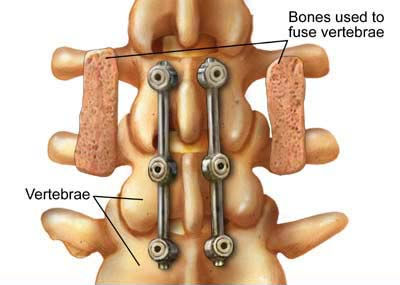The Low Down on Spinal Fusion Surgery
Spinal fusion surgery is a very serious and complicated operation. Depending on the person and their spinal curves, the surgery may be performed over two or three (rarely) separate operations - thank goodness I only need one! The goal of this post is to give all of the information I can, in a simplified way, of what spinal fusion surgery is, and how it will affect someone. Not everyone with Scoliosis requires surgery. My surgeon said that spinal fusion surgery is usually considered an option when a curve is greater than 45 degrees, or the Scoliosis is impairing bodily function or causing pain. There is also a relatively new technique called 'tethering' which is often performed on children, or young adolescents before they finish puberty. Most often in medicine, the earlier the intervention, the better the results!
Essentially, spinal fusion surgery uses metal screws and rods, as well as cadaver bone, to make several vertebra function as one bone. It looks like this:

Richards , W. [Diagram]. Retrieved from http://fitness4backpain.com/the-dos-and-donts-of-exercising-after-a-spinal-fusion/
To be very clear: SPINAL FUSION SURGERY DOES NOT GUARANTEE A PERFECTLY STRAIGHT SPINE! The amount of screws and rods, as well as the location of the rods, is completely dictated by each individual's spinal curves. The location where the fusion starts and ends will also be dependent on the individual. I'll know more about my personal surgery in about a month, but my surgeon said he believes my fusion would start around my fourth or fifth thoracic vertebrae, and end around my second lumbar vertebrae.
The surgery itself is lengthy, usually lasting several hours - but don't worry, the individual is under complete anesthesia (just think of it as a really long nap)! Since the operation takes a long time, there is an increased risk of infection due to the large, and open incision (most often on your back). To combat this, antibiotics are given during and after the surgery for a couple days to decrease the risk of infection.
People who get their spine fused are usually in the hospital for about a week, but very few tend to remember the first day, as they're heavily sedated still. Over the week-long period, the individual will learn (or re-learn - their legs work perfectly fine, it's just extremely sore to move) how to sit, stand, walk, step up stairs, and other basic movement skills that are required in everyday life. In most cases, around two to three weeks are spent at home resting and walking around - basically trying to regain independence and be able to function as normally as possible!
Pain medication is given at the hospital, and prescriptions are also given to keep the patient comfortable at home. I plan on taking pain medication when needed; however, I'd like to get off of taking medication as soon as I feel able, as there are many side-effects of pain medications (especially strong ones)!
Everyones experience is different with spinal fusion surgery; however, from what my surgeon has told me, I will have a pre-operation appointment, the surgery itself, a two week check-up for x-rays, a six week check-up, a six month check-up, and then a year check-up! Usually at around six weeks post-operation, the individual can start partaking in light swimming, and also start massage therapy, or other rehabilitation techniques! It is completely up to the individual what steps they take after their surgery; however, it is strongly encouraged to stay active and have daily physical activity (regardless if you're having surgery or not, staying active is very important)!
Although the individual will not be able to lift heavy things, and loses a significant amount of the range-of-motion and mobility in their spine, gradually they will adapt to tasks. It's not that they aren't able to have the same life they had before, it's just simply that they have to approach tasks in a new and creative way! For example, instead of flexing your spine to bend over and pick something up, they could try to bend at the hip, or even crouch down with their legs!
A couple blog posts ago, I did a Pros and Cons list of spinal fusion surgery, so make sure to check that out!
Here is more information and a video about the differences between vertebral spinal tethering and spinal fusion (performed at British Columbia Children's Hospital) from Global News:
This blog is my own personal experience and journey with Scoliosis. It is not a medical blog, and if anyone has concerns about their own health, they should see a physician.
Sources of Information:
1. https://www.healthlinkbc.ca/health-topics/hw62352